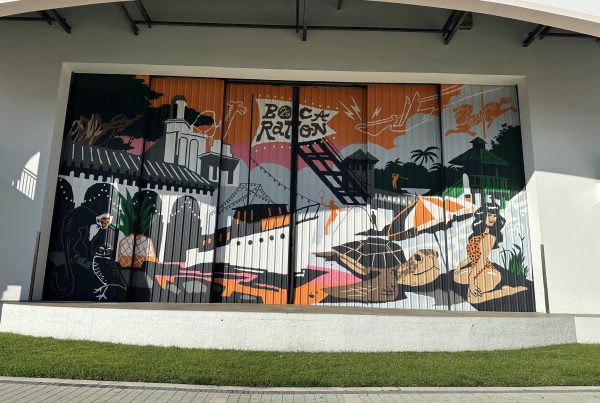As the Oscars of the design world, the prestigious Kips Bay Decorator Show House Palm Beach selected 23 of the nation’s most talented designers and architects to each curate a room inside a home in West Palm Beach’s SoSo neighborhood earlier this year. The resulting spaces were a peek into each designer’s imagination, personal aesthetic and firm ethos. In its seventh year, the show house, which attracts about 15,000 visitors yearly, continues to be a fundraiser for the Kips Bay Boys & Girls Club and Boys & Girls Clubs of Palm Beach County, and it has raised nearly $30 million for after-school programs.
Each of our five featured designers tackled their space in a unique and inspiring fashion, whether it was Jonathan Savage’s loungey multipurpose study, Ariel Okin’s verdant garden-style terrace, a small-but-mighty and whimsical Betsy Wentz-designed hallway, Jim Dove’s functionally stylish kitchen, or Cindy Rinfret and Taylor Stebbins’ serene primary bedroom. We dive into the experts’ inspo-worthy designs and share a few of their pro tips along the way.
Ariel Okin, Ariel Okin Interiors
OUTDOOR PATIO: “Trellis Garden”

As a Manhattan native, Okin grew up going to the Kips Bay show houses with her mom. In a full-circle moment this year, her firm was chosen to participate and was given the expansive second-floor terrace to design. Okin was inspired by the illustrious architects John Volk and Maurice Fatio and their classic Palm Beach architecture. Her talent in interpreting traditional design in her contemporary manner is apparent here—she transformed the stark white-walled, cement-floored space into a traditional garden-style space that didn’t feel dated or “granny-esque.” There were no plastic-covered sofas, ruffles or chintz here. Instead, Okin mixed materials and textures to make the terrace feel comfortable and inviting while also curated and current.
“I love classicism and interiors that are traditional, but I like them to feel pared back, tailored and crisp,” she explains.


The 4,500-square-foot space featured a mix of materials, from wicker and bamboo to glass and aluminum. She anchored the terrace with solid-hued upholstery and a sisal rug while adding color and pattern with her pillows, accessories and lampshades. For the uncovered portion of the terrace, Brown Jordan patio furniture featuring cooler tones was warmed with teak-base umbrellas and wicker accessories.
Her favorite feature is the stunning, hand-painted ceiling by West Palm Beach artist Joseph Steiert. Steiert’s delicate vines embrace the trellis’ Messel green (Southfield Green by Benjamin Moore) and add an element of surprise that invited nature into the design.
PRO TIPS: HOW TO CREATE A FUNCTIONAL OUTDOOR SPACE:
• Mix materials. Create a palette play of different textures to make it interesting. Combine different wicker materials from different brands to help it to feel more collected.
• Keep upholstery in a solid color, like white or pale blue, to feel clean, fresh and not too busy. Add accent colors with pillows and lampshades, but always ground large furniture with a solid color.
• Think about how you will use the space. Then you can get intentional about the floor plan. Ensure there are places to set a drink, and that conversation flows from a chair to a sofa.
Jonathan Savage, Savage Interior Design
LIBRARY/OFFICE: “The Savage Study”
Savage transformed a ground-floor room in the front of the house into a warm and inviting multi-dimensional space. He envisioned this as a serene place to gather one’s thoughts at the beginning of the day as well as somewhere to unwind at day’s end with a cocktail in hand. The room’s inspiration came from the Zimmer + Rohde drapery fabric, which reminded him of maritime flags and our boating culture. He built the space around this latest collection to create his version of Palm Beach. Pulling from the fabric’s color palette, Savage washed the walls in Benjamin Moore’s Mount Saint Anne and added a splash of glitz on the ceiling with a Phillip Jeffries high-gloss lacquer wall covering.


“It gave us an opportunity to use color in an unexpected way. In the end, I felt we had created a room with interest. When you can think through all the details, that’s when the room is a true success.”
Savage embraced the bookshelves as part of his vision for the study but filled in two with Casa Metier fluted moldings. He used the bookshelf’s same fluted moldings on the welcome bar. (He also carried the drapery fabric onto the plush Anees Upholstery chair; he has a talent for carrying a thought through without overdoing it.) He admits this is his favorite feature; the architectural detail added texture and accentuated the high ceilings while also creating a beautiful backdrop to showcase the custom color block art by Palm Beach artist William Finlayson.


Savage is no stranger to the show house; this is his third appearance. As its vice chair this year, he focused on cultivating an inclusive group of talented people who share a love for design. During the 30 days he spent with them, he developed a camaraderie he’ll treasure. “It’s a great opportunity to give to the wonderful charity, and it’s a wonderful platform for designers to get recognition for their hard work and efforts,” he says. His debut book, The Savage Style, is available now.
PRO TIPS: HOW TO CREATE A MULTIPURPOSE ROOM:
• Determine your end goal first. Focus on its livability. What do you want to be able to do here? Work from home and also sip on a great cocktail? Don’t be afraid to mix work and play.
• Choose furniture that’s both comfortable and functional. Chairs can be plush and relaxed, but you also need a place to put a drink. So use tables of different sizes around the space.
• If you want a room to feel tranquil, choose a wall color to exemplify that. You can also use it to highlight chosen fabric and art.
Betsy Wentz, Betsy Wentz Interior Design
LOUNGE: “The Parlour”

“We design happy spaces” is Wentz’s motto, and she did just that in this hallway-turned-lounge. Coming off the second-floor staircase landing and following a sharp left turn, Wentz’s whimsical maximalist world of color and pattern emerges, inspiring instant smiles. In her second appearance at the show house, Wentz showcased her talent for combining colors and patterns in a manner that is more harmonious than harrowing. She found her inspiration for the room’s uplifting mood in Harlequin’s partnership with designer Sophie Robinson. As a nod to the English brand, Wentz titled the lounge “The Parlour,” spelling it in the British style.
Wentz wanted to make the space functional as a pass-through hallway, thus anchoring it with a stunning built-in banquette and adding more seating with the sofa and custom petite ottomans draped in a playful beetle print. To pair patterns and colors that don’t necessarily match but also don’t clash—like the dark velvet patterned sofa on the patterned wall—Wentz kept the florals all in a similar scale and the same color family but used them in different textiles. To maintain some semblance of levity on the ceiling, Wentz kept it white to allow the Urban Electric light fixture to visually pop.


For Wentz, the banquette was the star of the show, embodying the flavor of the playful, whimsical room with its colors, curvy shape and heavy patterned back. She adores round shapes, so she designed a circular table custom-made by Bradley USA that allowed for ease of seating and didn’t distract from the banquette. She integrated functionality with a performance velvet seat in a solid color that gave the eye a sense of pause when taking in the entire room. As a Rob Tucker collector herself, Wentz hung one of his pieces above it to add to the room’s swanky vibe.
When picking art for a patterned wall, she advises not to worry too much about what might “go” in a space, comparing it to a fabric you would layer into a room—such as pairing a geometric and a floral, which almost always works. In this instance, the florals recess when teamed with the bold architecture of the art. On the adjacent wall, she framed two Hermès scarves that had the perfect color complement.

In the end, Wentz’s goal for this room, as with her new book Design Happy, was to offer insight and inspire guests to apply even one idea from the space in their home. “If things look good together, they look good together. It’s about conquering that fear of using pattern and color in spaces.”
PRO TIPS: HOW TO DESIGN A SMALL SPACE
• Small spaces don’t need to be neutral and simple. Think of a powder room or mudroom—they are pass-through spaces, so you can actually get away with adding a larger pattern. You can afford to take a risk.
• You do need a grounding element. Not everything can be the star. Think of a solid-color, larger upholstered piece to anchor the space. Or if you have a pattern on a wall, keep the flooring simple.
• Go big on lighting. Light fixtures are high up in the air, which is unclaimed real estate you can take advantage of.
Jim Dove, Jim Dove Design
KITCHEN: “Cordon Bleu”


Dove is a master at designing kitchens that don’t sacrifice function for style, and that is evident here. Durable Silestone countertops in a polished ethereal glow, a 72-inch range with eight burners, three sinks, two ovens, a griddle and a grill all share the space with towering cream palm trees, blush-pink cabinetry and a striking gold leaf coffee/cocktail bar. Inspired by the legendary designer Dorothy Draper, Dove embraced color. The room’s vibrant blue is complemented by dusty and flamingo pinks and crowned with a glamorous 110-glass-star Studio Bel Vetro chandelier. The Gracie Studio wallpaper enveloped the kitchen in a whimsical design that celebrates nature with a chic tropical undertone.
A kitchen’s hospitality is on full display in this space. Its expansiveness allowed Dove to designate several spaces where the homeowner and guests could embrace that joie de vivre as they overlook the pool and garden. Dove’s design feels furnished and warm and exudes a sophisticated character rather than the typical austere space filled with built-ins. The custom buffet credenza, with its crystal rose quartzite from Primestones, added warmth, while the regency-style cabinets with sherbet-hued alcoves added chic playfulness. “When I design a kitchen, I think of the space as a living room, and the cabinetry as its furniture.”

To warm the space even more, Dove inserted a red-brown tropical hardwood into the large island to define the area where guests can observe the chef and celebrate the art of cooking with a cocktail in hand. When ready for a refill, the highgloss lacquered blue bar is just steps away. Its contemporary design, complete with JennAir appliances, is elevated further with the elegant gold leaf design by local artist Jeff Arnold of Evolution Studios.

PRO TIPS: HOW TO DESIGN A FUNCTIONAL AND FASHIONABLE KITCHEN
• Select a style that resonates with you. Do you like minimalism? Farmhouse? Modern with touches of glamour? Once you’ve decided, carefully curate a complementary color palette. The key is ensuring all design elements seamlessly merge into a harmonious and visually pleasing whole.
• Think about how you will use the kitchen. Will you be hosting quite a lot? This will help you create a thoughtful layout and designate spaces for eating, preparing, cooking, serving and socializing.
• Look for durable, stain-resistant materials like Silestone. Also, consider how its tones and veins complement the color palette you’ve already chosen.
Taylor Stebbins and Cindy Rinfret, Rinfret, Ltd. Interior Design
PRIMARY BEDROOM: “Seashell Sanctuary”

Inspired by Vizcaya’s opulent shell grottos, Cindy Rinfret and Taylor Stebbins transformed the second-floor primary bedroom into a sophisticated oasis of intricate details and serene reflection. The room celebrates the delicate shell craftsmanship of Italian aristocratic palaces like Villa D’Este, as opposed to feeling like you stepped into Ariel’s bedroom in “The Little Mermaid.” They wanted to bring back the original spectacular take on shell grotto work and show how sophisticated shells can be. The mother-and-daughter duo and their design team embraced the show house’s “no rules” adage to play with new ideas. They created a space they wouldn’t necessarily design for a client by showing visitors the artistry of what can be done.

Two striking examples are distinctive wall panels and the canopy bed with its embroidered coverlet. Exploring a new way to incorporate a shell design that wasn’t necessarily actual shells, the team worked with de Gournay to create the wall panels, which were hand-painted onto silk, then hand-embroidered with raffia and beading, and finally paper-backed so they could be installed like wallpaper. “It was a good experiment for the vendor and us to develop these new concepts that were absolutely fabulous,” Rinfret explains.
The bed was equally unique. The team worked with Palm Beach shell artist Robin Grubman to design a surprise shellscape on the underside of the iced marbled canopy. They then teamed up with de Gournay to create embroidery that flows from the headboard to the pillow onto the coverlet and down to the sofa, a nod to the cascading fountains of Vizcaya.
The designers wanted to explore the preservation of our oceans as an underlying theme for the room. Rinfret reminisces about the shells and reefs she discovered on trips to the Bahamas as a child. Sadly, she has noticed the lack of shells at the beach on more recent trips. “Shells are nature’s antiques,” she says. “So this was to honor Vizcaya and also to inspire people to protect these beautiful things.”

The ceiling’s wood veneer Phillip Jeffries parquet wall covering was another quiet detail. Its muted hue adds to the space’s overall soft tonality and, thus, its sense of serenity. The team also added architectural detailing through the base, crown, ceiling and wall moldings to give it a classic design that was then refreshed with actual shells on the cornices and the shell design on the wall panels.
“Our rooms unfold and are collected,” Rinfret says. “And I think that’s what makes them feel so comfortable. The more you’re there, the more you sort of discover.”

PRO TIPS: HOW TO LEAN INTO A THEME WITHOUT CROSSING A KITSCHY LINE
• Pick the star of the show. Everything can’t be important, and there’s a difference between being important and being beautifully detailed.
• Select a palette with colors that are tonally in the same range and value. Also, opt for sophisticated colors that can work as a backdrop for the room.
• Regardless of what motif you choose, carry it through the room using different techniques, materials and textures (e.g., light fixtures with just a hint of the motif). Remember, restraint is just as important.
This edition of Florida Style & Design is from the July/August 2024 issue of Boca magazine. For more like this, click here to subscribe to the magazine.







